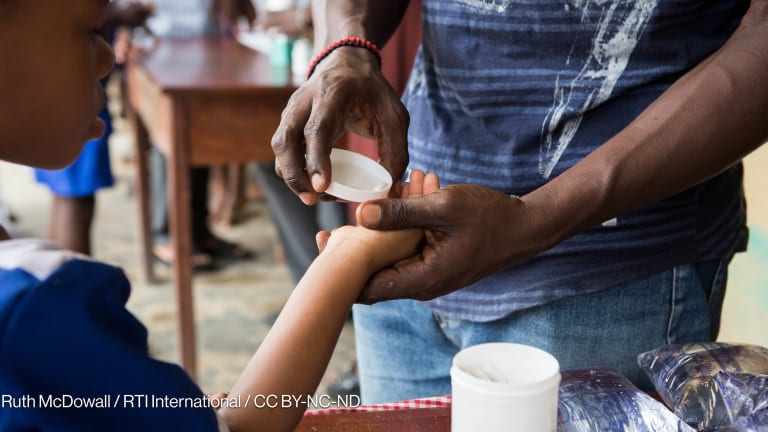Can innovative models close financing gaps for neglected disease R&D?
Diseases such as dengue, cholera, and leptospirosis are on the rise globally, yet funding for tests, vaccines, and treatments remains limited. A new study highlights innovative financing mechanisms that could help.
Vaccines, tests, and treatments for neglected diseases, such as dengue, will require innovative financing mechanisms to incentivize manufacturers to prioritize them and ensure they reach populations that need them, according to a new study. Lifesaving medical interventions are a product of years to decades of research and development, which typically costs billions of dollars. But funding for neglected diseases R&D is often limited and uneven, with high-profile diseases getting more investments than others. Not enough funding is allocated for the late-stage development of products, including for large-scale trials to evaluate a product’s efficacy and safety; licensing and World Health Organization prequalification, which is a requirement for the procurement of international procuring agencies; and commercialization, according to the landscape study of South and Southeast Asia by AVPN, Wellcome Trust, and Access Partnership. This is in part because this stage requires huge capital, yet the expected financial returns are limited, said Dhun Davar, chief of programs and deputy CEO at AVPN. “Developers tend to face high costs for Phase III trials, regulatory approvals, and manufacturing, while the purchasing power of health systems in endemic countries is often too weak to create predictable demand. Without a viable commercial pathway, private-sector participation remains constrained — a clear example of ‘market failure,’” she told Devex, adding this leaves many promising vaccines and diagnostics struggling to move through the final stages of development to become accessible. But she said innovative financing mechanisms, such as pooled procurement, advance market commitments and product development partnerships, could help close these gaps. How innovative finance could help Of the $4.17 billion in R&D funding for neglected diseases in 2023, the majority — about 66% — went toward high-profile diseases such as HIV, tuberculosis, and malaria, while only a small fraction supported diseases such as dengue and leptospirosis. Just 2.7% went to dengue, despite it causing millions of infections each year and requiring treatment and more comprehensive prevention tools. Only 0.1% went to leptospirosis, a disease that affects 1 million people globally each year and causes nearly 60,000 deaths. Leptospira, the bacterium that causes leptospirosis, gets transmitted to humans through contact with soil or water contaminated with the urine of infected animals, particularly rodents. The risk for both diseases is increasing due to the frequency of adverse weather events and changing climate patterns. However, no treatments currently exist for dengue fever, only supportive care. Meanwhile, there is no widely available vaccine for leptospirosis, current tests are slow or unreliable, and no treatments are in late-stage development, according to the study. The study suggests that an advance market commitment — where funders commit to purchase a product during the development stage thereby guaranteeing a market for it — could help incentivize the development of antiviral treatments for dengue, helping derisk private investments and encourage manufacturers to prioritize its R&D. Product development partnerships, meanwhile, where public, private, and philanthropic organizations work together to advance the development of lifesaving innovations, could be useful for the development of treatments and tests for leptospirosis, as they share risks and expertise in developing these innovations. Such partnerships are particularly well-suited to diseases such as leptospirosis that lack well-defined markets and strong demand forecasts, according to the study. Another financing mechanism is pooled procurement, where different buyers consolidate their purchases, buy in bulk, and help secure lower prices for products. This mechanism could ease supply constraints by signaling predictable demand for existing and new vaccines for cholera, a diarrheal disease that can be fatal without prompt treatment and is currently experiencing a global resurgence. An estimated 1 billion people are at risk of cholera worldwide, according to WHO. No formal pooled procurement mechanisms currently exist in South and Southeast Asia, where cholera is endemic in some countries. But Davar said the Asian Development Bank “is already exploring a pooled procurement model for the region.” At AVPN, they are also working to convene and connect governments, philanthropic funders, development banks and private investors “to explore how such a mechanism could take shape in Asia.” An ‘inflection point’ for Asian funders Asia bears a huge burden of these neglected diseases, but funding, especially for late stage R&D for infectious diseases in the continent remains limited, with most catalytic capital coming from global philanthropic organizations and regional development banks, Davar said. However, she said “this also signals an inflection point for Asian funders” such as philanthropies, family offices, corporations and development finance institutions to coinvest in mechanisms that serve regional needs. An “Asia Infectious Disease Technology Fund” could serve as a blended finance mechanism, for example, pooling grants, concessional loans, and private capital to de-risk investment in diagnostics, vaccine trials, and manufacturing capacity. A pooled R&D fund governed by institutions located in the region could also allow Asian governments and foundations to make coordinated, multiyear commitments to advance priority diseases in the region. But Asian funders can do much more beyond helping fill funding gaps in R&D. They can also help boost the region’s limited clinical trials networks, regulatory systems and manufacturing and cold-chain capacities that also serve as key barriers slowing the region’s ability to bring lifesaving innovations to market, Davar said. Philanthropists, for example, can fund the training of clinical trial staff and regulators, and invest in quality data systems in the region. Regional banks such as the ADB and the Asian Infrastructure Investment Bank can offer concessional financing and blended instruments for building R&D laboratories and cold-chain infrastructure. “At the end of the day, addressing these nonfinancial barriers takes more than capital. We need collaboration. Only when science, capital, and coordination move together can innovation truly serve public health across Asia,” Davar said.
Vaccines, tests, and treatments for neglected diseases, such as dengue, will require innovative financing mechanisms to incentivize manufacturers to prioritize them and ensure they reach populations that need them, according to a new study.
Lifesaving medical interventions are a product of years to decades of research and development, which typically costs billions of dollars. But funding for neglected diseases R&D is often limited and uneven, with high-profile diseases getting more investments than others.
Not enough funding is allocated for the late-stage development of products, including for large-scale trials to evaluate a product’s efficacy and safety; licensing and World Health Organization prequalification, which is a requirement for the procurement of international procuring agencies; and commercialization, according to the landscape study of South and Southeast Asia by AVPN, Wellcome Trust, and Access Partnership.
This story is forDevex Promembers
Unlock this story now with a 15-day free trial of Devex Pro.
With a Devex Pro subscription you'll get access to deeper analysis and exclusive insights from our reporters and analysts.
Start my free trialRequest a group subscription Printing articles to share with others is a breach of our terms and conditions and copyright policy. Please use the sharing options on the left side of the article. Devex Pro members may share up to 10 articles per month using the Pro share tool ( ).
Jenny Lei Ravelo is a Devex Senior Reporter based in Manila. She covers global health, with a particular focus on the World Health Organization, and other development and humanitarian aid trends in Asia Pacific. Prior to Devex, she wrote for ABS-CBN, one of the largest broadcasting networks in the Philippines, and was a copy editor for various international scientific journals. She received her journalism degree from the University of Santo Tomas.








